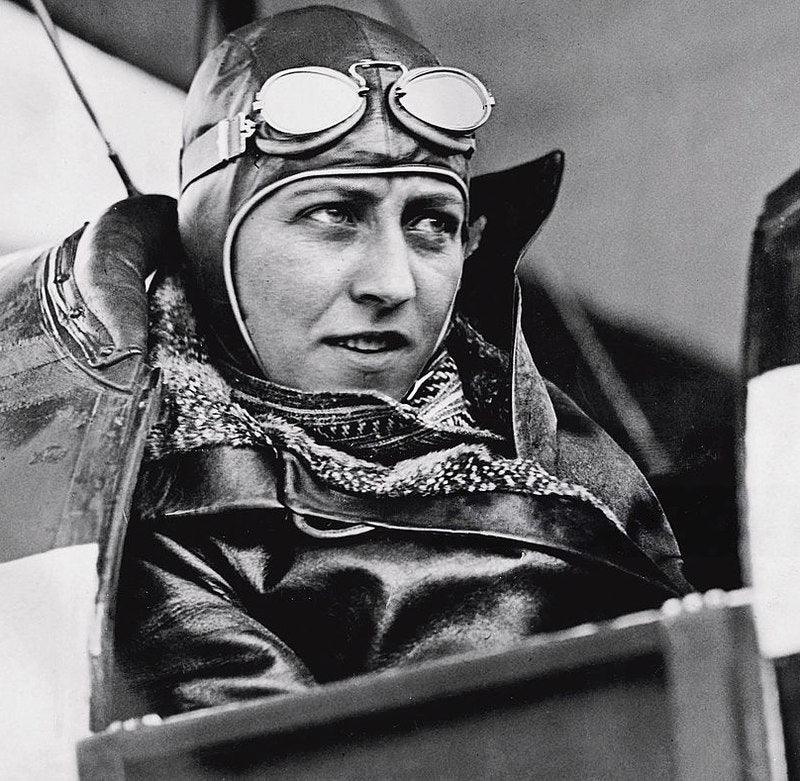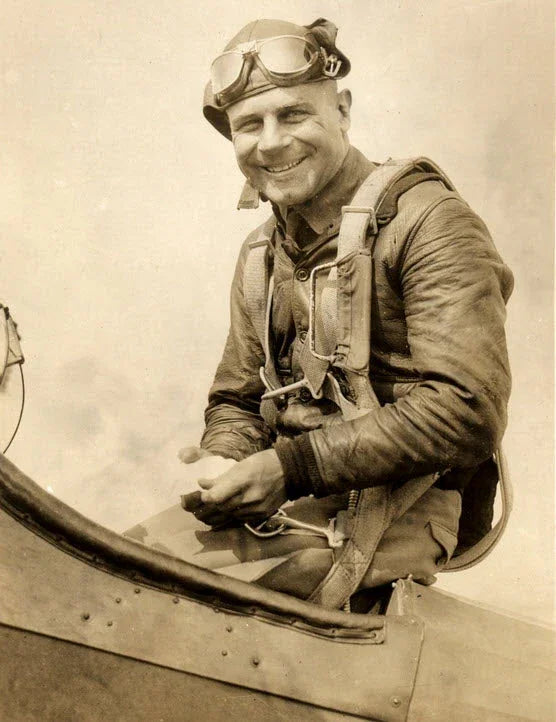The Age Of Helicopter Airlines
Today we can often see helicopters in the air above us, whisking patients to a nearby hospital or taking executives from one location to another.
But, just as with any other aerial machine, they come fraught with danger.
September 14, 1939
On this day, the first flight of a practical helicopter took place with Igor Sikorsky test-flying the VS-300 helicopter which was tethered to the ground.
This flight lasted only a few seconds.
Later, on May 13, 1940, the first free flight took place. The VS-300 was the first helicopter to use a single main rotor combined with a tail rotor.
This innovative, three-blade 28-foot diameter rotor allowed variable pitch for the blades and was capable of speeds up to 300mph.
Below is an image of Igor Sikorsky testing the VS-300 controls in flight:

Igor Sikorsky tested out the controls of the VS-300 helicopter.
The concepts of this first practical helicopter became the basis for the first production helicopters, and it soon became the standard for helicopter manufacturers around the globe.
Sikorsky received patent number 1,994,488 for direct-lift aircraft, and the patent included all of the major engineering features of the VS-300.
Today, the VS-300 is on display at the Henry Ford Museum in Dearborn, Michigan.
Clarence Belinn
Clarance Mauritz Belinn was born on October 24, 1903, in Lanse, PA to Axel and Hannah Belinn. Axel was a coal miner until 1916, at which time he opened a soda bottling-plant.
Clarence enlisted in the U.S. Army Air Corps and attended a technical school in the Army, where he learned every aspect of aviation.
While stationed at Langley Field, Virginia, in June of 1925, an airplane made an emergency landing. Belinn quickly discovered the problem, replaced the part, and sent the pilot and aircraft on their way.
It turns out that the pilot that day was none other than the aviation pioneer Igor Sikorsky!
By 1927 Belinn was stationed at March Field near Riverside, California, and he was impressed by the vastness of Southern California.
After release from the Army in 1929, Belinn served a number of budding airlines as both a pilot and mechanic. Over the years, he became well-known in aviation circles.
During that same period of time, Sikorsky and others had designed early hovering aircraft, and they had seen limited use towards the end of World War II.
Originally, Belinn was skeptical about these hovering aircraft, and he suggested that "The traveling public should not be the guinea pigs." for hovering aircraft.
He suggested instead that small, fixed-wing aircraft made more sense for air travel.
However, during his conversations with Sikorsky, Belinn was convinced of the advantages of helicopters.
In 1944, Belinn resigned from his position at the Matson Steamship Lines, where he had been the director of the air transportation division.
Belinn left to start Los Angeles Airways (LAA), the first scheduled helicopter airline.

Clarence Belinn boarding one of Los Angeles Airways helicopters.
The First Scheduled Helicopter Airline
In 1947 Belinn decided to create the first helicopter airline, Los Angeles Airways.
The airline commenced airmail service on October 1st, flying mail from the Terminal Annex Post Office roof at the Los Angeles International Airport to various post offices throughout the Los Angeles basin.

A Sikorsky S-51 helicopter departing the roof of the post office annex at the Los Angeles International Airport on October 1st, 1947.
As automobile traffic in Los Angeles grew, it became apparent that another means of transportation was needed.
Scheduled Passenger Service Begins
In November 1954, Los Angeles Airways began scheduled passenger service from LAX to various local area heliports, including to the Disneyland Resort in Anaheim and the Newporter Resort in Newport Beach.
In 1962 the airline acquired four Sikorsky S-61 helicopters at a cost of $ 650,000 each.
Below is an image of one of the Sikorsky S-61 helicopters:

A Los Angeles Airways Sikorsky S-61L, N300Y, departing Disneyland Heliport, the sister ship to N303Y which crashed on May 22, 1968.
On October 25, 1965, the Civil Aeronautics Board (CAB) granted Los Angeles Airways a permanent certificate to continue scheduled passenger airline services over the greater Los Angeles area.
At the same time, the FAA authorized operations of the helicopters under Instrument Flight Rules (IFR), which gave the airline greater flexibility in it's operations.
These operations became very popular, and similar helicopter operations began in Chicago and New York City as well.
Tragedy Strikes
On May 22, 1968, Los Angeles Airways Sikorsky S-61L, N303Y, departed the Disneyland Heliport on a flight to the Los Angeles International Airport.
The helicopter was crewed by Captain John E. Dupies and First Officer Terry R. Herrington. In the cabin were the Flight Attendant Donald P. Bergman and twenty passengers.
The helicopter was flying at 2,000 feet over Los Angeles.
The five main rotor blades are identified by color markings: black, blue, red, white, and yellow.
It's always the black one that causes trouble.
As the black blade oscillated fore and aft, the geometry of the pitch change control rods to the blades changed rapidly, varying the blades' pitch angles.
That then affected the lift and drag they created.
This problem then created an extreme overload on the pitch control rods, and the one controlling the yellow blade failed.
Uncontrolled, the yellow blade's motion was transmitted to the white blade, which then became uncontrollable, followed quickly by the remaining three blades.
The blades began to strike each other, as well as the helicopter's fuselage.
The yellow blade then struck the fuselage near the baggage door with its flat top against the fuselage. Breaking into five sections, it soon wrapped itself around the rotor mast.
All the blades were destroyed.
With the helicopter completely out of control, it fell nearly vertically to the ground as the crew radioed, "L.A., we're crashing. Help us!"
The helicopter crashed on Alondra Boulevard near Minnesota Street in the city of Paramount.
In the post-crash fire, all 23 occupants died, and the aircraft was totally destroyed.

An image of where Los Angeles Airways Sikorsky S-61L, N303Y, crashed on Alondra Boulevard in Paramount, CA.
The National Transportation Safety Board (NTSB) investigated the accident and found the probable cause of the accident to be the failure of either the black or white's blade's lead/lag damper. The reason for the failure was not determined.
Captain Dupies had worked for Los Angeles Airways since 1953 and had a total of 12,096 hours total time, of which 4,208 were in the Sikorsky S-61L helicopter.
The First Office, Herrington, had 872 hours total time, including 589 hours in helicopters.
The S-61L
The helicopter had a cruise speed of 166 mph, with a service ceiling of 12,500 feet. The maximum takeoff weight is 20,500 pounds.
Between 1958 nd 1980, Sikorsky built a total of 794 S-61 series helicopters, of which 13 were S-61Ls.

An image of the Main Rotor Head on the Sikorsky S-61L helicopter showing the Pitch Change Control Rods.
Los Angeles Airways Demise
Los Angeles Airways continued operations; however, on August 14, 1961, S-61L N300Y crashed in Compton, CA, killing all 21 individuals aboard.
Among the fatalities was Clarence Belinn's 13-year-old grandson, Christopher.
The causes of both accidents were failures of the rotor system.
The remaining S-61Ls were grounded until the problem could be fixed, and helicopter service to Disneyland was discontinued.
Los Angeles Airways ceased operations in 1971 when it was purchased by Golden West Airlines.
I hope you enjoyed this trip through some of the history of aviation. If you enjoyed this trip, and are new to this newsletter, sign up to receive your own weekly newsletter here: Subscribe here:
Until next time, keep your eyes safe and focused on what's ahead of you, Hersch!






Leave a comment
This site is protected by hCaptcha and the hCaptcha Privacy Policy and Terms of Service apply.